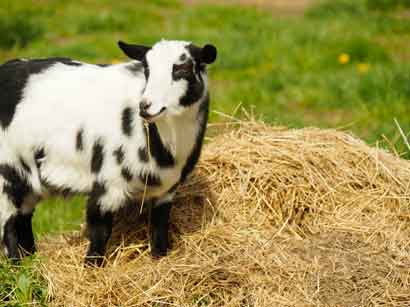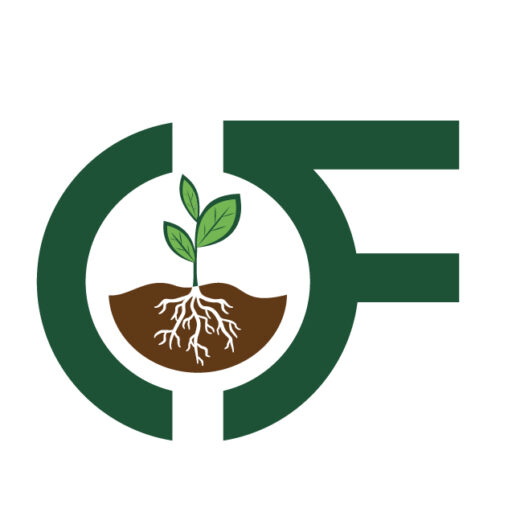How to Choose the Right Hay for Your Livestock
For livestock owners and farmers, choosing the right type of hay is a crucial decision. Hay serves as a primary source of nutrition for animals like cattle, horses, sheep, and goats, and making the wrong choice can have a significant impact on their health and productivity. We will explore the factors to consider when selecting livestock hay, different types of hay available, and how to assess hay quality to ensure your animals receive the best nutrition.

(Black and white goat eating hay)
Factors to Consider When Choosing Hay for Livestock- The Ohana Way
Before diving into the various types of hay, it’s essential to understand the factors that should guide your decision when selecting hay for your livestock:
- Livestock Species: Different livestock species have varying nutritional requirements. Cattle, horses, sheep, and goats all have specific dietary needs, so consider the type of livestock you’re feeding and get livestock grade hay. Make sure you choose the right hay for your horses or other livestock.
- Age and Life Stage: The age and life stage of your animals play a crucial role in hay selection. Growing animals, pregnant or lactating females, and mature adults have different nutritional needs.
- Purpose: Are your animals being raised for meat, milk, or work? The purpose of your livestock can influence the type of hay you should provide to meet their energy and nutrient requirements.
- Budget: Hay prices can vary depending on type and quality. Consider your budget when choosing hay to ensure it’s cost-effective for your operation.
- Storage and Availability: Assess your storage capacity and the availability of different types of hay in your region. Proper livestock hay storage is essential to maintain hay quality.
Types of Hay for Livestock
Several types of hay are commonly fed to livestock, each with its own nutritional profile. Here are some of the most popular options:
- Grass Hay: Grass hay is made from various grasses such as timothy, bermuda grass, and orchard grass. It is typically lower in protein and energy compared to legume hays, making it suitable for mature, non-lactating animals. Grass hay is an excellent choice for cattle, horses, and sheep.
- Legume Hay: Legume hay, including alfalfa, clover, and peanut hay, is higher in protein and energy compared to grass hay. It is a suitable choice for young and growing animals, pregnant or lactating females, and animals with high energy demands. Legume hay is often fed to cattle, horses, goats, and sheep.
- Mixed Hay: Mixed hay blends grasses and legumes, providing a balanced nutritional profile. It can be an excellent choice for a variety of livestock species, offering a combination of fiber, protein, and energy.
- Timothy Hay: Timothy hay is a popular choice for rabbits and guinea pigs due to its high fiber content and moderate protein levels. It is also suitable for adult horses, cattle, and sheep.
- Orchard Grass Hay: Orchard grass hay is similar to timothy hay in terms of nutrition and is suitable for a range of livestock species.
Assessing Hay Quality
Once you’ve determined the type of hay that best suits your livestock’s needs, it’s crucial to assess hay quality. Quality hay ensures your animals receive the necessary nutrients in hay for live a long healthy life. Here are some factors to consider when evaluating hay quality:
- Color: High-quality hay should have a greenish color, indicating that it was harvested at the optimal stage of maturity. Avoid hay that is brown or yellow, as it may have lost nutritional value.
- Texture: The texture of hay should be soft, pliable, and free from excessive stems or coarse material. Coarse hay can be difficult for animals to digest and may have lower nutritional value.
- Smell: Good-quality hay should have a fresh, sweet, and grassy smell. Hay that smells musty, moldy, or overly fermented should be avoided, as it may be harmful to livestock.
- Leafiness: Leafy hay is generally higher in nutritional value than stemmy hay. Look for hay with a higher proportion of leaves and fewer stems.
- Lack of Dust and Mold: Inspect the hay for dust and mold. Dusty or moldy hay can be harmful to animals and should never be fed.
- Nutrient Content: Consider having the hay tested for its nutrient content, including protein, fiber, and mineral levels. This can provide valuable information to help you balance your livestock’s diet effectively.
Balancing Your Livestock's Diet
Once you’ve selected the right type of hay and assessed its quality, it’s essential to balance your livestock’s diet for optimal nutrition. Hay is a crucial component of their diet, but it may not provide all the necessary nutrients on its own. Consider the following:
- Supplements: Depending on your livestock’s specific needs, you may need to provide supplements such as minerals, vitamins, and protein sources to ensure a well-rounded diet.
- Forage Analysis: Conduct a forage analysis to determine the exact nutrient content of your hay. This analysis can help you tailor your supplement strategy to meet your livestock’s requirements.
- Consult a Nutritionist: If you have questions or concerns about your livestock’s diet, consider consulting with a livestock nutritionist. They can provide expert guidance and formulate a balanced ration.
Storage and Handling Tips
Proper storage and handling are essential to maintaining hay quality. Here are some tips:
- Keep Hay Dry: Hay should be stored in a dry environment to prevent mold growth. Use well-ventilated storage areas or cover hay with tarps to protect it from moisture.
- Elevate Hay: Store hay on pallets or raised platforms to prevent contact with moisture from the ground.
- Rotate Stock: Use the oldest hay first to prevent spoilage and ensure your animals receive fresh feed.
- Inspect Regularly: Periodically inspect your hay for signs of mold, pests, or contamination, and remove any affected bales immediately.
Invest in Proper Equipment: Use appropriate feeding equipment, such as hay racks or a livestock hay feeder, to minimize waste and keep hay clean.
Hay Storage Done Right
Choosing the right hay for your livestock is a critical decision that directly impacts their health and well-being. Consider factors like livestock species, age, purpose, budget, and availability when selecting hay. Assess hay quality based on color, texture, smell, leafiness, and lack of dust and mold. Balance your livestock’s diet with supplements and consult with a nutritionist if needed. Proper storage and handling are crucial to maintaining hay quality and ensuring that your animals receive the best possible nutrition. By following these guidelines, you can provide your livestock with the nutritious hay they need to thrive.

